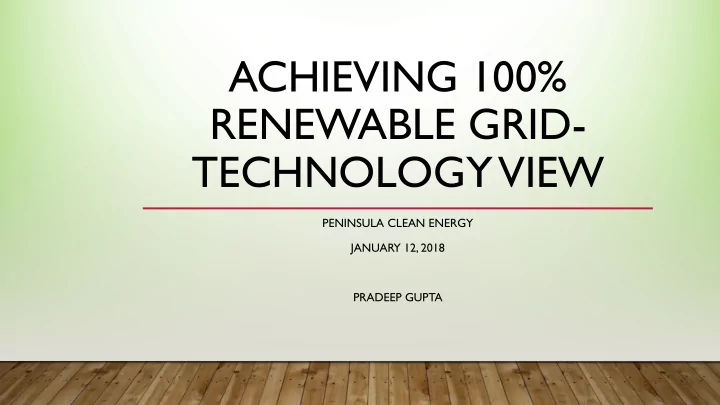

ACHIEVING 100% RENEWABLE GRID- TECHNOLOGY VIEW PENINSULA CLEAN ENERGY JANUARY 12, 2018 PRADEEP GUPTA
VARIABLE RENEWABLE ENERGY (VRE) • Annual VRE penetration level = Fraction of annual energy (kWh) met by VRE • Instantaneous VRE penetration level= Fraction of instantaneous power (kW) met by VRE at any point in time.
DEALING WITH VARIABILITY AND UNCERTAINTY • Electric load is highly variable. • Conventional generators can easily change power output to meet load. • Wind and solar have uncertain power output determined by local weather. • Greater grid flexibility required as VRE increases. • VRE generators (solar and wind) are highly correlated geographically so larger net load ramps in the evenings
POSSIBLE SOLUTIONS • Sufficient geographic diversity of VRE sites. • Expansion of transmission system to move VRE power to areas needing power. • Greater coordination among balancing authority areas. • Energy storage from times of excess VRE energy to times of need. • Several storage technologies- pumped hydropower fleet, compressed air energy storage, batteries. Demand response technologies to shift load demand. • New loads that have flexibility in use pattern- EV charging.
HIGHER VRE IMPACTS GRID RELIABILITY • Current grid is dominated by central station conventional synchronous generators • Higher VRE penetration results in higher instantaneous VRE. • Higher than 50% instantaneous VRE will change to inverter based grid.
What is Inverter Dominated Grid ?
SYNCHRONOUS GENERATORS CHARACTERISTICS • Synchronous generators create ac electricity at fixed frequency 60 Hz. • Once synchronized to the grid, the output is controlled easily: • Real power (frequency) output by controlling shaft torque. • Reactive power (voltage) by controlling so called field current. • Reliable grid operation (freq and voltage) obtained by automatic generator controls (AGC). • Synchronous generators have built in synchronizing torque which stabilizes the system after a system disturbance.
SYNCHRONOUS GENERATORS CHARACTERISTICS • Physics- huge mechanical inertia of rotors and turbines store significant kinetic energy. • Interconnected system of generators are able to withstand fluctuations in net load and generations with small changes in sytem frequency. • Frequency deviation is inversely proportional to net inertia. • Net inertia, AGC and synchronizing torque allows mitigation of large real and reactive power imbalances in the grid. • This fundamentally important characteristic will change with inverter based generation.
VRE TECHNOLOGIES GRID INTERFACE
VRE TECHNOLOGIES GRID INTERFACE • Power electronics interface called inverters. • Converts DC to AC • Manages flow of energy by controlling switching semiconductor devices very rapidly. • Strictly electronics- no rotating masses or mechanical components. • Battery storage is not VRE but is needed for energy balance in high VRE systems and uses inverters.
CONTROLLERS FOR VRE TECHNOLOGIES • Closed loop controllers • Digital controllers • Processing real time measurements • Chosen control strategy dictates electrical dynamics during disturbances not the physical properties. • Two classes of inverters: • Grid following • Grid forming
GRID FOLLOWING INVERTERS • Manipulated electronics to inject current in to the grid that tracks the sinusoidal grid voltage, or “follows” the voltage at its terminals. • Pre assumption: “stiff” ac voltage with minimal voltage and frequency deviations is maintained. • Historically this assumption held well with low VRE. • But with high VRE with grid following inverter dominated grid, it is not true.
NEXT GENERATION GRID FORMING INVERTERS • Challenges to be addressed • Will be realized gradually over years as synchronous generators are replaced • Smaller in power rating so large population- millions • Characteristics: • Compatible with existing systems • Decentralized to reduce fast communications requirements • Able to operate without synchronous generators • Advanced control methods for active power, reactive power and power quality
NEXT GENERATION GRID FORMING INVERTERS • Approaches • Droop control • Virtual synchronous machines with inertia • Emerging synchronization of coupled oscillators with digital control.
POWER SYSTEM STABILITY
NEW PILOT PROJECTS AT SCE • The Advanced Research Projects Agency-Energy (ARPA-E) Network Optimized Distributed Energy Systems (NODES) • GE Global Research’s Synthetic Reserves from Aggregated Distributed Flexible Resources project • National Renewable Energy Laboratory ’s project, Real- Time Optimization and Control of Next-Generation Distribution Infrastructure, that unifies real-time voltage and frequency control at the home/DER controllers’ level with network-wide energy management at the utility/aggregator level. • Pacific Northwest National Laboratory’s Multi-Scale Incentive-Based Control of Distributed Assets project will develop and test a hierarchical control framework for coordinating the flexibility of a full range of DERs, including flexible building loads, to supply reserves to the electric power grid.
CALIFORNIA ENERGY COMMISSION SMART INVERTER FIELD DEMONSTRATION PROJECT • EPRI/ SCE field testing of a standard modular interface of inverters with any communications protocols. • SUNSPEC/ SCE project to demonstrate the ability of residential DER assets to provide ancillary grid services while being managed through an aggregator.
CPUC/DOE/CEC/SCE- INTEGRATED GRID PROJECT 1. SP1: Substation and Distribution- better state estimation by data, monitoring sensors 2. SP2: Distributed Volt/VAR Control (DVVC)- CEC Smart Inverter Project- controlling VAR at DERs. 3. SP3: Distributed Energy Management- controlling DER and storage to avoid overloads. 4. SP4: Virtual Microgrid- control power flow on single point connection to the grid. 5. SP5: Incentive Mechanisms for customers to offer DER for aggregation. 6. SP6: Field Area Network- faster communications network to collect process data 7. SP7: Cybersecurity 8. SP8: Integration- integration of applications from various vendors 9. SP9: Distributed Optimized Storage- make storage visible to grid operator, available to wholesale market when not needed. 10. SP10: Beyond the Meter- aggregation of DER behind the meter through web based network.
CONCLUSIONS • 100% VRE poses technology challenges. • 100% VRE grids will require Better ways to match supply demand • New systems with high VRE compatible with existing systems • Design of inverter based systems to provide grid services for system stability • Design to acknowledge large number of inverters. • • With proper controls. Inverter based systems can maintain and improve system stability. • Improved coordination- law makers, utilities, resource providers, customers, vendors of hardware and software. • CEC/ PUC/ DOE/ SCE field projects testing new technologies.
Recommend
More recommend